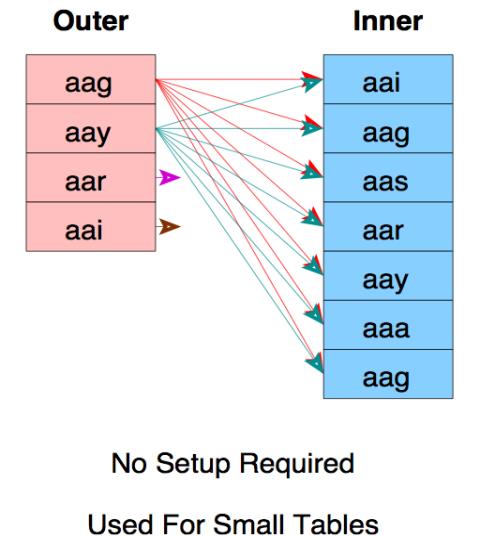PG中的物理连接方式
Posted 瀚高PG实验室
tags:
篇首语:本文由小常识网(cha138.com)小编为大家整理,主要介绍了PG中的物理连接方式相关的知识,希望对你有一定的参考价值。
目录
环境
系统平台:Linux x86-64 Red Hat Enterprise Linux 7
版本:10.3
详细信息
一、物理连接方式概要
规划器和优化器中真正复杂的事情与表连接有关,根本上讲,两个表以任何方式连接都会生成相同的输出,区别在于执行效率。
PG支持以下3种表连接操作:
Nested Loop Join
Merge Join
Hash Join
1、Nested Loop Join(嵌套循环连接)
Nested Loop是扫描一个表(外表),每读到一条记录,就根据Join字段上的索引去另一张表(内表)里面查找,若Join字段上没有索引查询优化器一般就不会选择 Nested Loop;
内表在Join字段上建有索引;外表也叫“驱动表”,一般为小表,不仅相对其它表为小表,而且记录数的绝对值也较小,不要求有索引;
外表返回的每一行都要在内表中检索找到与它匹配的行,因此整个查询返回的结果集不能太大(大于1 万不适合)
若Join字段上没有索引查询优化器一般就不会选择 Nested Loop;
被连接的数据子集较小的情况,Nested Loop是个较好的选择。
嵌套循环的顺序扫描如下图:

嵌套循环的索引扫描如下图:

2、Merge Join(合并连接或归并连接)
Merge join的操作通常分三步:
1)对连接的每个表做table access full;
2)对table access full的结果进行排序;
3)进行merge join对排序结果进行合并;
在全表扫描比索引范围扫描再进行表访问更可取的情况下,Merge Join会比Nested Loop性能更佳;当表特别小或特别巨大的时候,实行全表访问可能会比索引范围扫描更有效;Merge Join的性能开销几乎都在前两步;Merge Join可适用于非等值Join(>,<,>=,<=,但是不包含!=,也即<>);通常情况下Hash Join的效果都比排序合并连接要好,如果两表已经被排过序,在执行排序合并连接时不需要再排序了,这时Merge Join的性能会更优。
3、Hash Join(哈希连接或散列连接)
优化器使用两个比较的表,并利用连接键在内存中建立散列表,然后扫描较大的表并探测散列表,找出与散列表匹配的行,适用于较小的表完全可以放于内存中的情况,这样总成本就是访问两个表的成本之和;但如果表很大,不能完全放入内存,优化器会将它分割成若干不同的分区,把不能放入内存的部分写入磁盘的临时段,此时要有较大的临时段以便提高I/O的性能。 只能应用于等值连接(如WHERE A.COL3 = B.COL4),这是由Hash的特点决定的。哈希连接是归并连接的主要替代方案,哈希连接并不会对输入进行排序;能够很好的工作于没有索引的大表和并行查询的环境中,并提供最好的性能。是否比其他连接方式高效,取决于输入的内容是否经过排序。
二、物理连接的应用对比
| 类别 | Nested Loop | Hash Join | Merge Join |
| 使用条件 | 任何条件 | 等值连接(=) | 等值或非等值连接(>,<,=,>=,<=),‘<>’除外 |
| 相关资源 | CPU、磁盘I/O | 内存、临时空间 | 内存、临时空间 |
| 特点 | 当有高选择性索引或进行限制性搜索时效率比较高,能够快速返回第一次的搜索结果。 | 当缺乏索引或者索引条件模糊时,Hash Join比Nested Loop有效。通常比Merge Join快。在数据仓库环境下,如果表的记录数多,效率高。 | 当缺乏索引或者索引条件模糊时,Merge Join比Nested Loop有效。非等值连接时,Merge Join比Hash Join更有效 |
| 缺点 | 当索引丢失或者查询条件限制不够时,效率很低;当表的纪录数多时,效率低。 | 为建立哈希表,需要大量内存。第一次的结果返回较慢。 | 所有的表都需要排序。它为最优化的吞吐量而设计,并且在结果没有全部找到前不返回数据 |
三、实验:不同物理连接查询时间消耗对比
| #构建测试数据库和表 create database db16; \\c db16 You are now connected to database "db16" as user "postgres". create table orders ( id serial, placed date ); create table items ( id serial, order_id integer, amount money ); insert into orders(placed) select current_date from generate_series(1,1000000); #构造百万数据行 insert into items(order_id,amount) select mod(s.id,1000000)+1, random()*100::money from generate_series(1,10000000) as s(id); #构造千万数据行
alter table orders add constraint orders_pkey primary key(id); alter table items add constraint items_pkey primary key(id); alter table items add constraint items_id_fkey foreign key (order_id) references orders(id); create index on items(order_id); analyze orders; analyze items; #嵌套查询消耗(最佳执行计划) explain analyze select i.* from orders o join items i on (o.id = i.order_id) where o.id between 1 and 100; QUERY PLAN --------------------------------------------------------------------------------------------------------------------------------------- Nested Loop (cost=0.86..4532.11 rows=1021 width=16) (actual time=0.020..2.421 rows=1000 loops=1) -> Index Only Scan using orders_pkey on orders o (cost=0.42..10.69 rows=113 width=4) (actual time=0.011..0.039 rows=100 loops=1) --外表 Index Cond: ((id >= 1) AND (id <= 100)) Heap Fetches: 100 -> Index Scan using items_order_id_idx on items i (cost=0.43..39.92 rows=9 width=16) (actual time=0.002..0.020 rows=10 loops=100) #内表items Index Cond: (order_id = o.id) Planning time: 2.937 ms Execution time: 3.037 ms (8 rows) #对比哈希连接查询消耗 set enable_nestloop=off; explain analyze select i.* from orders o join items i on (o.id = i.order_id) where o.id between 1 and 100; QUERY PLAN -------------------------------------------------------------------------------------------------------------------------------------------- Hash Join (cost=12.10..191576.23 rows=1021 width=16) (actual time=0.086..4659.744 rows=1000 loops=1) Hash Cond: (i.order_id = o.id) -> Seq Scan on items i (cost=0.00..154054.22 rows=9999922 width=16) (actual time=0.011..2297.875 rows=10000000 loops=1) -> Hash (cost=10.69..10.69 rows=113 width=4) (actual time=0.067..0.067 rows=100 loops=1) Buckets: 1024 Batches: 1 Memory Usage: 7kB -> Index Only Scan using orders_pkey on orders o (cost=0.42..10.69 rows=113 width=4) (actual time=0.009..0.041 rows=100 loops=1) Index Cond: ((id >= 1) AND (id <= 100)) Heap Fetches: 100 Planning time: 0.268 ms Execution time: 4659.941 ms (10 rows) #hash连接查询消耗时间非常多,此查询使用hash连接很低效,适用循环嵌套连接方式。
#另一个查询计划和时间消耗对比 #合并连接查询聚合消耗 explain analyze select o.id, sum(i.amount) from orders o join items i on (o.id = i.order_id) group by o.id; QUERY PLAN -------------------------------------------------------------------------------------------------------------------------------------------------------------- GroupAggregate (cost=2.58..653492.70 rows=1000000 width=12) (actual time=0.050..14463.784 rows=1000000 loops=1) Group Key: o.id -> Merge Join (cost=2.58..598293.68 rows=9039804 width=12) (actual time=0.026..10862.823 rows=10000000 loops=1) Merge Cond: (o.id = i.order_id) -> Index Only Scan using orders_pkey on orders o (cost=0.42..28220.42 rows=1000000 width=4) (actual time=0.015..424.372 rows=1000000 loops=1) Heap Fetches: 1000000 -> Index Scan using items_order_id_idx on items i (cost=0.43..452205.19 rows=9999922 width=12) (actual time=0.007..5723.775 rows=10000000 loops=1) Planning time: 0.897 ms Execution time: 14653.730 ms (9 rows) #嵌套连接查询聚合消耗 set enable_nestloop=on; set enable_mergejoin=off; set enable_hashjoin=off; explain analyze select o.id, sum(i.amount) from orders o join items i on (o.id = i.order_id) group by o.id; 更多详细信息等登陆【瀚高支持平台查看】瀚高技术支持平台 |
以上是关于PG中的物理连接方式的主要内容,如果未能解决你的问题,请参考以下文章